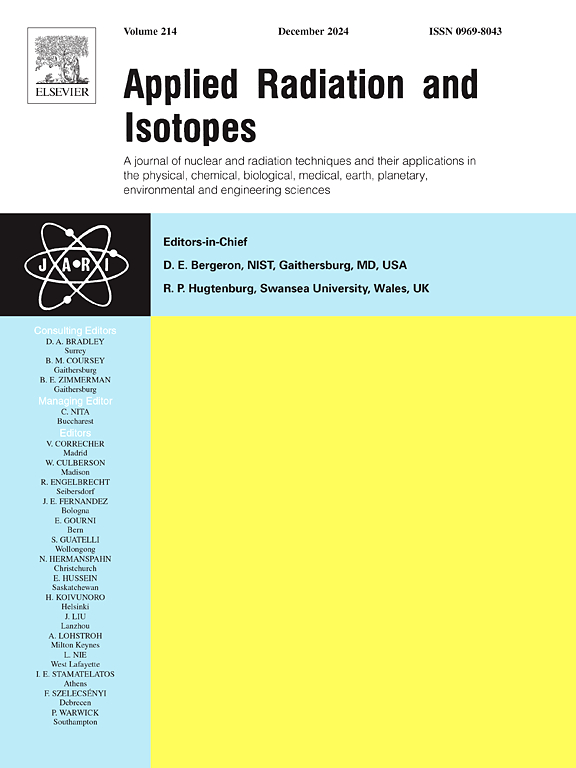High-resolution alpha-particle spectrometry of 243Am
IF 1.8
3区 工程技术
Q3 CHEMISTRY, INORGANIC & NUCLEAR
引用次数: 0
Abstract
Alpha particles emitted by a thin 243Am source were detected with an energy resolution of 9–10 keV in a planar ion-implanted silicon semiconductor detector. A magnet system was installed above the source to deflect conversion electrons emitted quasi-coincidentally with the alpha particles, thus strongly reducing sum peaks from simultaneous detections that would distort the energy spectrum. In addition, measurements were performed at different distances between the source and detector surfaces, to verify whether the energy spectra were insensitive to variations in geometrical efficiency. Peak shapes were fitted to the energy spectrum, the alpha-particle emission probabilities determined, the uncertainty budget calculated, and the results compared with literature values.
243Am的高分辨率α粒子光谱分析
在平面离子注入硅半导体探测器中,以9-10 keV的能量分辨率检测了243Am薄源发射的α粒子。在源上方安装了一个磁铁系统,以偏转与α粒子准巧合发射的转换电子,从而大大减少了同时探测的和峰,从而扭曲了能谱。此外,在源和探测器表面之间的不同距离上进行了测量,以验证能谱是否对几何效率的变化不敏感。对能谱进行峰形拟合,确定α粒子发射概率,计算不确定性预算,并与文献值进行比较。
本文章由计算机程序翻译,如有差异,请以英文原文为准。
求助全文
约1分钟内获得全文
求助全文
来源期刊

Applied Radiation and Isotopes
工程技术-核科学技术
CiteScore
3.00
自引率
12.50%
发文量
406
审稿时长
13.5 months
期刊介绍:
Applied Radiation and Isotopes provides a high quality medium for the publication of substantial, original and scientific and technological papers on the development and peaceful application of nuclear, radiation and radionuclide techniques in chemistry, physics, biochemistry, biology, medicine, security, engineering and in the earth, planetary and environmental sciences, all including dosimetry. Nuclear techniques are defined in the broadest sense and both experimental and theoretical papers are welcome. They include the development and use of α- and β-particles, X-rays and γ-rays, neutrons and other nuclear particles and radiations from all sources, including radionuclides, synchrotron sources, cyclotrons and reactors and from the natural environment.
The journal aims to publish papers with significance to an international audience, containing substantial novelty and scientific impact. The Editors reserve the rights to reject, with or without external review, papers that do not meet these criteria.
Papers dealing with radiation processing, i.e., where radiation is used to bring about a biological, chemical or physical change in a material, should be directed to our sister journal Radiation Physics and Chemistry.
 求助内容:
求助内容: 应助结果提醒方式:
应助结果提醒方式:


